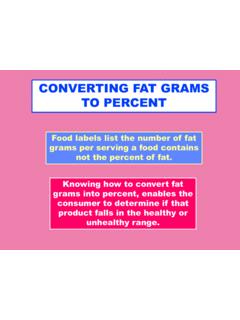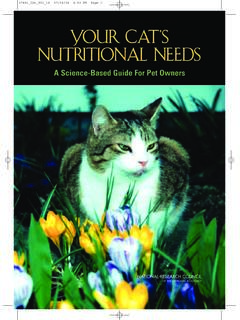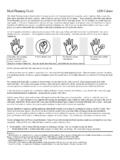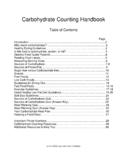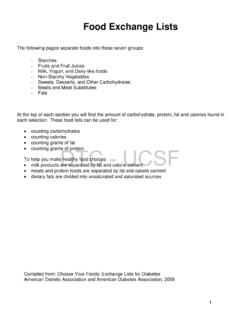Transcription of Lifestyle Coach Facilitation Guide: Core
1 Lifestyle Coach Facilitation guide : core Session 2: Be a Fat and Calorie Detective Table of Contents Background and Preparation Page Preparation Checklist Materials Required for Session 2 Before You Begin 2 Lifestyle Coach Brief Learning Objectives Session Overview Key Messages 6 Classroom Presentation Part 1: Weekly Progress and Review Weigh-in Week in Review Keeping Track This Week 7 Part 2: Tracking Your Weight Tracking Your Progress How Am I Doing? Weight chart Tracking Your Weight at Home 10 Part 3: Self-Monitoring Fat Intake Fat and Calorie Relationship Eating Less Fat Effect of Too Much Fat High-Fat Foods Hidden Fat Cutting Down on Fat fat gram Goals Fat and Calorie Counter Estimating Fat and Calories Nutrition Labels Tracking Fat and Calorie Totals 12 Part 4: Wrap Up and To-Do List To Do Next Week 27 Follow Up Notes and Homework 29 Session 2: Be a Fat and Calorie Detective Lifestyle Coach Facilitation guide : core Background and Preparation Preparation Checklist Materials These are the materials that you will need during Session 2.
2 Session 2 handouts: Session 2 Overview Be a Fat and Calorie Detective What High Fat Foods Do You Eat? Sample Lunch Menu Tracking Fat and Calories fat gram Goal Fat and Calorie Counter Guidelines Adding Up Fat Grams Eating Packaged Foods To Do Next Week Copies of ground rules generated during Session 1 food and Activity Trackers for Session 2. Label the tracker with the session name and number. P rovide extra copies for those who need them. How Am I Doing? weight charts. Have one for each participant with his or her starting and goal weight already written in. Participants will keep and use these charts for the remainder of the program. Lifestyle Coach s Log Fat and Calorie Counter Name tags or tents from the previous week, if still needed Flip chart or chalk board supplies Optional: food samples for activity in Part 3: Self-Monitoring Fat Intake 2 Session 2: Be a Fat and Calorie Detective Materials (continued) Measuring cups, spoons, ruler, and food scale Balance scale.
3 Use the same one each week to weigh participants. Before you begin Choose a private place to weigh participants. If still needed, prepare name tags or set up the classroom with name tents from the previous week. Have your Lifestyle Coach Log s ready for weigh-ins. Learning objectives At the close of this session, the participants will be able to Self-monitor their weight during the weeks following Session 2. Document their weight at home and at the beginning of each session. Describe the relationship between fat and calories. Explain the reason for, and basic principles of, self-monitoring fat grams and calories. Identify their personal fat gram goals. Use the Fat and Calorie Counter to calculate the calories and fat grams of a given selection of foods. Keep a running total of the fat grams they eat each day. Calculate fat, calories, and serving sizes from nutrition labels. Lifestyle Coach Facilitation guide : core 3 Session 2: Be a Fat and Calorie Detective Session 2 overview Session 2 focuses on self-monitoring our weight and calculating the amount of fat and the number of calories we eat crucial elements of the National Diabetes Prevention Program.
4 The Lifestyle Coach and participants begin to use the How Am I Doing? weight chart for tracking individual progress on weight loss (and later physical activity) throughout the program. Participants will calculate their individual fat gram goals and see how reducing calories results in weight loss. Being a fat and calorie detective involves recognizing high-fat and high-calorie foods and then reducing the fat and calories in our diet in order to lose weight and prevent disease. Session 2 is divided into four parts. Part 1: Weekly Progress and Review (10 minutes) This section will be the same for each session. Participants will be weighed privately and then asked to take their seats in the classroom. You will review briefly the information covered during the previous session, then lead a discussion about group members successes, challenges, and questions since they last met. Part 2: Tracking Your Weight (10 minutes) You will explain how participants should track their weight at home.
5 They will also learn how to track their in-class weights on the How Am I Doing? weight chart so they can see their progress over time. You filled in the first week s weight for each participant. From now on, you will continue to weigh each participant every week, but they will record in-class weights on their own. You will use an example How Am I Doing? chart to show participants how to enter their weight on the charts. Participants will keep their own chart and bring them to class each week for the remainder of the program. Part 3: Self-Monitoring Fat Intake (30 minutes) This section explains the importance of participants monitoring their fat and calorie intake. They will also learn the health effects of eating fat and how to determine what kinds of foods are high in fat and calories. Self-monitoring fat intake begins this week. Participants will be asked to write down all the foods they eat and to use the Fat and Calorie Counter to Lifestyle Coach Facilitation guide : core 4 Session 2: Be a Fat and Calorie Detective track their daily intake.
6 They will also be assigned an individual fat gram goal, which is a budget that they should try to stay below. Calories and their relationship to fat are discussed, and participants are also asked to track calories in addition to fat intake, although no calorie goal is assigned. Optional activity: If time allows, you may do an exercise that allows participants to practice recognizing high-fat and high-calorie foods. Bring foods (just the packages or models are fine) to the class and ask participants to name the foods they should limit. Or have participants estimate the fat grams in a given food . Discuss the fat and calorie content of each. Part 4: Wrap-Up and To-Do List (10 minutes) This final part will be the same for most sessions: a summary of what was covered and a discussion of the tasks participants will do during the next week. Lifestyle Coach Facilitation guide : core 5 Session 2: Be a Fat and Calorie Detective Lifestyle Coach Brief Key messages Here are the key messages for this session.
7 They should be reinforced from time to time throughout the program. Consistent self-monitoring of weight and food intake are keys to maintaining a long-term focus on weight loss goals. Many tools and guides will help establish healthy eating habits. Participants should become familiar with how they work and use them regularly. Participants should learn to estimate quickly the amount of fat and calories in various foods and to understand the language of labels and ingredients. Having these skills will enable them to choose foods that fall within their fat gram budget. Because fats are so high in calories, reducing fat is a relatively easy way of reducing the number of calories we eat. Reducing fat has secondary health benefits for people at high risk for type 2 diabetes: reducing fat lowers cholesterol and reduces risk for heart attack. Lifestyle Coach Facilitation guide : core 6 Session 2: Be a Fat and Calorie Detective Lifestyle Coach Facilitation guide : core Classroom Presentation Part 1: Weekly Progress and Review Estimated time: 10 minutes Weigh In Notes As each participant arrives Weigh him or her privately.
8 Record each participant s weight on the Lifestyle Coach s Log. Give each participant the Session 2 handouts. Inform participants that you will show them later how to record their weight on their How Am I Doing? weight chart . At that time, they will practice recording this week s weight. Week in Review Notes Distribute the list of ground rules generated by the class during Session 1. Review ground rules, and ask the group whether they want to change or add any rule to ensure sessions run smoothly. Present: Last week, we reviewed the purpose and goals of this program and introduced you to the key concepts we will focus on during the coming weeks. You were given a Participant Notebook, a set of handouts, and a to-do list to work on during the week. You were also introduced to the food and Activity Tracker, which will help you track your weight and food . 7 Session 2: Be a Fat and Calorie Detective Ask: How are you feeling this week about your goals and what we are here to do?
9 Open responses. Present: As we progress in this program, monitoring your weight and how much you eat will become a more natural part of your Lifestyle . We will work together to overcome challenges you meet along the way. Keeping Track Notes Ask: How did keeping track of what you ate and drank go last week? Were you able to write down everything that you ate and drank? Open Responses. Note to Lifestyle Coach It is important to prevent this discussion from turning into a gripe session. Address challenges, but keep the tone positive. Ask about successes and accomplishments. Ask: What did you learn by this process? About your habits? What difficulties did you have? Open Responses. Present: At the end of this session I will collect your food and Activity Trackers from Session 1. I will review your tracking notes and make comments. Your trackers will be returned to you next session. They will not be graded!
10 The purpose is to allow me to give personal feedback that will help you reach your goals. Lifestyle Coach Facilitation guide : core 8 Session 2: Be a Fat and Calorie Detective Present: Sometimes it s difficult to monitor what you eat closely enough to know where you need to make changes. For those of you who had trouble, tell me what happened. Open responses. Ask group to suggest options for those who struggled. Present: In this program, we will help you overcome difficulties in tracking your progress. I know most of you are trying and are making strides toward self-monitoring. This Week Notes Present: This week we will learn how to be fat and calorie detectives. We will become aware of the amount of fat and the number of calories we eat. We will learn how knowing the amount we eat will help us lose weight. We will Discuss how to monitor your weight at home.











